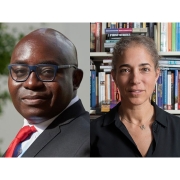Harnessing DNA Tricks to Boost Nanosensors

In a new paper published in Nano Letters, postdoctoral fellows Zhaoli Gao and Han Xia, with guidance from faculty member A.T. Charlie Johnson, combined a trick of DNA engineering which involves an engineered piece of DNA called a hairpin, with biosensors, increasing the sensitivity of the sensors by a factor of 50,000 in less than an hour.
The biosensors the physics and astronomy researchers are working with are made with graphene, a one-atom-thick material that is perfectly two-dimensional. Because of this, it can be used as an extremely sensitive way of detecting biological signals, measuring the current that flows through graphene surface in the presence of biomolecules. When DNA or RNA molecules bind to the graphene, it produces a big change in the conductivity of the atomically thin material, allowing the researchers to detect infections and to measure viral loads.
One possible application of this technique is in portable and inexpensive diagnostic devices capable of detecting an infectious agent in people simply and conveniently and with enough sensitivity to catch it before the level of infection becomes very large.
“One example would be people with HIV who are being treated, either with current antiretroviral therapy, or with new approaches that are being developed," says Johnson, a professor of physics and astronomy. “If their treatment starts to fail and the level of virus starts to grow, it would be important to catch it quickly and when it's at a relatively low level. It might be possible to combine the sensor with some other sample handling methods so that people might be able to monitor their viral load themselves at home, as opposed to having to go to the doctor. It might even be possible to use it in low-resource settings, parts of the world that don’t have access to the technology needed for this kind of monitoring.”
Click here to read the full story.





